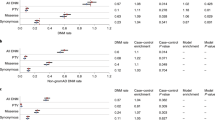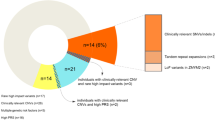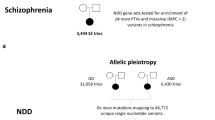Abstract
Schizophrenia is a highly polygenic disorder with important contributions from both common and rare risk alleles. We analyzed exome sequencing data for de novo variants (DNVs) in a new sample of 613 schizophrenia trios and combined this with published data to give a total of 3,444 trios. In this new data, loss-of-function (LoF) DNVs were significantly enriched among 3,471 LoF-intolerant genes, which supports previous findings. In the full dataset, genes associated with neurodevelopmental disorders (n = 159) were significantly enriched for LoF DNVs. Within these neurodevelopmental disorder genes, SLC6A1, which encodes a γ-aminobutyric acid transporter, was associated with missense-damaging DNVs. In 1,122 trios for which genome-wide common variant data were available, schizophrenia and bipolar disorder polygenic risk were significantly overtransmitted to probands. Probands carrying LoF or deletion DNVs in LoF-intolerant or neurodevelopmental disorder genes had significantly less overtransmission of schizophrenia polygenic risk than did non-carriers, which provides a second robust line of evidence that these DNVs increase liability to schizophrenia.
This is a preview of subscription content, access via your institution
Access options
Access Nature and 54 other Nature Portfolio journals
Get Nature+, our best-value online-access subscription
$29.99 / 30 days
cancel any time
Subscribe to this journal
Receive 12 print issues and online access
$209.00 per year
only $17.42 per issue
Buy this article
- Purchase on Springer Link
- Instant access to full article PDF
Prices may be subject to local taxes which are calculated during checkout



Similar content being viewed by others
Data availability
DNVs discovered from the new trios are published in Supplementary Table 12. The data that support the findings of this study are available from the corresponding author upon reasonable request.
Code availability
A description of the R functions used for statistical analysis can be found in the Life Sciences Reporting Summary.
References
Sullivan, P. F., Daly, M. J. & O’Donovan, M. Genetic architectures of psychiatric disorders: the emerging picture and its implications. Nat. Rev. Genet. 13, 537–551 (2012).
Ripke, S. et al. Genome-wide association analysis identifies 13 new risk loci for schizophrenia. Nat. Genet. 45, 1150–1159 (2013).
Lee, S. H. et al. Estimating the proportion of variation in susceptibility to schizophrenia captured by common SNPs. Nat. Genet. 44, 247–250 (2012).
Schizophrenia Working Group of the Psychiatric Genomics Consortium. Biological insights from 108 schizophrenia-associated genetic loci. Nature 511, 421–427 (2014).
Pardiñas, A. F. et al. Common schizophrenia alleles are enriched in mutation-intolerant genes and in regions under strong background selection. Nat. Genet. 50, 381–389 (2018).
Rees, E., O’Donovan, M. C. & Owen, M. J. Genetics of schizophrenia. Curr. Opin. Behav. Sci. 2, 8–14 (2015).
Singh, T. et al. The contribution of rare variants to risk of schizophrenia in individuals with and without intellectual disability. Nat. Genet. 49, 1167–1173 (2017).
Genovese, G. et al. Increased burden of ultra-rare protein-altering variants among 4,877 individuals with schizophrenia. Nat. Neurosci. 19, 1433–1441 (2016).
Satterstrom, F. K. et al. Novel genes for autism implicate both excitatory and inhibitory cell lineages in risk. Preprint at bioRxiv https://doi.org/10.1101/484113 (2018).
Sanders, S. J. et al. Insights into autism spectrum disorder genomic architecture and biology from 71 risk loci. Neuron 87, 1215–1233 (2015).
Deciphering Developmental Disorders Study. Prevalence and architecture of de novo mutations in developmental disorders. Nature 542, 433–438 (2017).
Kosmicki, J. A. et al. Refining the role of de novo protein-truncating variants in neurodevelopmental disorders by using population reference samples. Nat. Genet. 49, 504–510 (2017).
Singh, T. et al. Rare loss-of-function variants in SETD1A are associated with schizophrenia and developmental disorders. Nat. Neurosci. 19, 571–577 (2016).
Steinberg, S. et al. Truncating mutations in RBM12 are associated with psychosis. Nat. Genet. 49, 1251–1254 (2017).
Fromer, M. et al. De novo mutations in schizophrenia implicate synaptic networks. Nature 506, 179–184 (2014).
Howrigan, D. et al. Schizophrenia risk conferred by protein-coding de novo mutations. Preprint at bioRxiv https://doi.org/10.1101/495036 (2018).
Rees, E. et al. Analysis of intellectual disability copy number variants for association with schizophrenia. JAMA Psychiatry 73, 963–969 (2016).
International Schizophrenia Consortium. et al. Common polygenic variation contributes to risk of schizophrenia and bipolar disorder. Nature 460, 748–752 (2009).
Purcell, S. M. et al. A polygenic burden of rare disruptive mutations in schizophrenia. Nature 506, 185–190 (2014).
Bergen, S. E. et al. Joint contributions of rare copy number variants and common SNPs to risk for schizophrenia. Am. J. Psychiatry 176, 29–35 (2018).
Tansey, K. E. et al. Common alleles contribute to schizophrenia in CNV carriers. Mol. Psychiatry 21, 1085–1089 (2015).
Niemi, M. E. K. et al. Common genetic variants contribute to risk of rare severe neurodevelopmental disorders. Nature 562, 268–271 (2018).
Weiner, D. J. et al. Polygenic transmission disequilibrium confirms that common and rare variation act additively to create risk for autism spectrum disorders. Nat. Genet. 49, 978–985 (2017).
Karczewski, K. et al. Variation across 141,456 human exomes and genomes reveals the spectrum of loss-of-function intolerance across human protein-coding genes. Preprint at bioRxiv https://doi.org/10.1101/531210 (2019).
Samocha, K. E. et al. Regional missense constraint improves variant deleteriousness prediction. Preprint at bioRxiv https://doi.org/10.1101/148353 (2017).
Deciphering Developmental Disorders Study. Large-scale discovery of novel genetic causes of developmental disorders. Nature 519, 223–228 (2015).
Kirov, G. et al. De novo CNV analysis implicates specific abnormalities of postsynaptic signalling complexes in the pathogenesis of schizophrenia. Mol. Psychiatry 17, 142–153 (2012).
Gazal, S. et al. Linkage disequilibrium-dependent architecture of human complex traits shows action of negative selection. Nat. Genet. 49, 1421–1427 (2017).
Keller, M. C. Evolutionary perspectives on genetic and environmental risk factors for psychiatric disorders. Annu. Rev. Clin. Psychol. 14, 471–493 (2018).
Rees, E., Moskvina, V., Owen, M. J., O’Donovan, M. C. & Kirov, G. De novo rates and selection of schizophrenia-associated copy number variants. Biol. Psychiatry 70, 1109–1114 (2011).
Lek, M. et al. Analysis of protein-coding genetic variation in 60,706 humans. Nature 536, 285–291 (2016).
Pocklington, A. J. et al. Novel findings from CNVs implicate inhibitory and excitatory signaling complexes in schizophrenia. Neuron 86, 1203–1214 (2015).
Gottesman, I. I. & Shields, J. A polygenic theory of schizophrenia. Proc. Natl Acad. Sci. USA 58, 199–205 (1967).
McKenna, A. et al. The genome analysis toolkit: a MapReduce framework for analyzing next-generation DNA sequencing data. Genome Res. 20, 1297–1303 (2010).
DePristo, M. A. et al. A framework for variation discovery and genotyping using next-generation DNA sequencing data. Nat. Genet. 43, 491–498 (2011).
Li, H. & Durbin, R. Fast and accurate short read alignment with Burrows–Wheeler transform. Bioinformatics 25, 1754–1760 (2009).
Jun, G. et al. Detecting and estimating contamination of human DNA samples in sequencing and array-based genotype data. Am. J. Hum. Genet. 91, 839–848 (2012).
Samocha, K. E. et al. A framework for the interpretation of de novo mutation in human disease. Nat. Genet. 46, 944–950 (2014).
Ware, J. S., Samocha, K. E., Homsy, J. & Daly, M. J. Interpreting de novo variation in human disease using denovolyzeR. Curr. Protoc. Hum. Genet. 87, 7.25.1–7.25.15 (2015).
McLaren, W. et al. The ensembl variant effect predictor. Genome Biol. 17, 122 (2016).
The Brainstorm Consortium et al. Analysis of shared heritability in common disorders of the brain. Science 360, eaap8757 (2018).
Deelen, P. et al. Genotype harmonizer: automatic strand alignment and format conversion for genotype data integration. BMC Res. Notes 7, 901 (2014).
Euesden, J., Lewis, C. M. & O’Reilly, P. F. PRSice: polygenic risk score software. Bioinformatics 31, 1466–1468 (2015).
Acknowledgements
The work at Cardiff University was supported by Medical Research Council Centre Grant no. MR/L010305/1 (M.J.O.) and Program Grant no. G0800509 (M.J.O, M.C.O’D., J.T.R.W., V.E.-P., P.H. and A.J.P.), European Community Seventh Framework Programme Grant no. HEALTH-F2-2010-241909 (Project EU-GEI, M.C.O’D.), and European Union Seventh Framework Programme for research, technological development, and demonstration Grant no. 279227 (CRESTAR Consortium, M.C.O’D. and J.T.R.W.). We acknowledge L. Bates and L. Hopkins, at Cardiff University, for laboratory sample management. We acknowledge M. Einon, at Cardiff University, for support with the use and setup of computational infrastructures.
Author information
Authors and Affiliations
Consortia
Contributions
M.C.O’D., M.J.O., J.T.R.W., P.H. and E.R. conceived and designed the research. E.R. analyzed the data. J.H., J.M. and N.C. performed and managed the sequencing experiments. J.H. and M.D. performed the Sanger sequencing validation experiment. V.E.-P., A.J.P., L.H., S.E.L., A.F.P. and A.L.R. contributed to the interpretation of the results. T.L., N.K., V.K., V.G., M.P., J.G.-P., C.A., GROUP Investigators, M.G., J.R., G.K., J.T.R.W., M.C.O’D. and M.J.O. led the acquisition of the clinical samples. E.R., M.C.O’D. and M.J.O. wrote the manuscript, which was read, edited and approved by all authors.
Corresponding authors
Ethics declarations
Competing interests
M.C.O’D., M.J.O., P.H., J.T.R.W. and A.J.P. are supported by a collaborative research grant from Takeda. Takeda played no part in the conception, design, implementation, funding or interpretation of this study. All other authors declare no competing interests.
Additional information
Peer review information Nature Neuroscience thanks Ryan Yuen and the other, anonymous, reviewer(s) for their contribution to the peer review of this work.
Publisher’s note Springer Nature remains neutral with regard to jurisdictional claims in published maps and institutional affiliations.
Supplementary information
Supplementary Information
Ethics statement; Sample description; Supplementary Figures 1–4; CNV analysis; Principal component analysis; Sequencing coverage information; Alternative de novo enrichment tests; Supplementary Table legends.
Supplementary Table
Supplementary tables 1–14.
Rights and permissions
About this article
Cite this article
Rees, E., Han, J., Morgan, J. et al. De novo mutations identified by exome sequencing implicate rare missense variants in SLC6A1 in schizophrenia. Nat Neurosci 23, 179–184 (2020). https://doi.org/10.1038/s41593-019-0565-2
Received:
Accepted:
Published:
Issue Date:
DOI: https://doi.org/10.1038/s41593-019-0565-2



